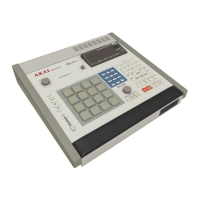Section 3: Recording sequences 55
3.8 The TIMING CORRECT key
The TIMING CORRECT function has many uses:
• It can correct timing errors made while recording.
• It can add a shuffle or swing timing to your performance.
• It can shift notes earlier or later in the sequence to compensate for
synthesizer delays, etc.
• It is used to set the STEP SIZE, used in STEP EDIT
• It can assist in the recording of repeating notes, such as rolls and repeated
1/16 notes or 1/32 notes.
3.8.1 Correcting timing errors
The MPC60 corrects any timing errors made while recording by moving
those errors onto the nearest 1/16 note. If a note is played a little too early,
it is moved later onto the nearest 1/16 note; if a note is played a little too
late, it is moved earlier onto the nearest 1/16 note (A value of 1/16 notes is
most often used, although this may be changed to one of six values, or
timing correction may be defeated entirely). This correction of errors is
done in real time as the notes are recorded, so playback of corrected notes is
instantaneous. Also, it is possible to correct the timing of notes which were
previously recorded.
One of the problems with timing correction (sometimes called
"quantizing") is that on many sequencers it has the effect of
truncating, deleting or elongating notes, making the feature
impractical to use. The MPC60 avoids this problem by only
correcting the attacks of a note, then moving the end of the note
along with the attack - the note duration is not changed. This allows
the corrected notes to sound much closer to the original performance,
but without the timing errors.
Another problem with timing correction on most sequencers is that all
events are corrected along with the notes. This can have the undesirable
effect of converting pitch bends into pitched "stair steps". The MPC60
avoids this problem by only correcting the notes, while recording the
continuous events such as pitch bends exactly as played. This allows, for
example, the notes of a keyboard solo to be corrected but the pitch bends to
be recorded exactly as played.
To inspect or change the timing correction settings, press TIMING
CORRECT while the MPC60 is not playing, and the following screen will
be displayed:

